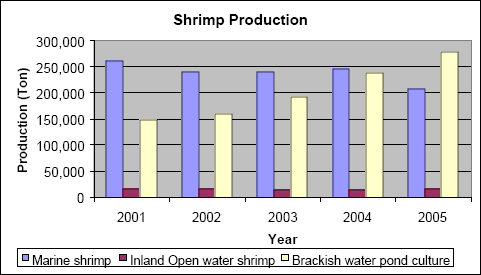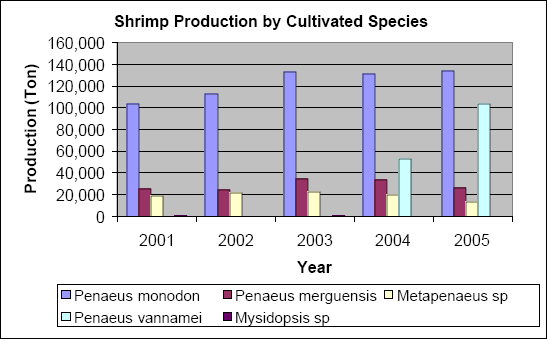Report Highlights:
Shrimp farming production continues to grow while traditional shrimp catch production is decreasing. Penaeus monodon accounts for the largest share of production though Penaeus vannamei appears to overtake it. Penaeus vannamei is largely cultivated by semi-intensive and intensive farming. Indonesian shrimp producers are facing virus attacks that decrease production and antibiotic residues that result in restrictions by destination countries. Because shrimp comes from various sources, production can not be fully traced and standards are inconsistent. Indonesia as an archipelago surrounded by seas and oceans possessing a large potential supply of seafood products, including a variety of fish, shrimp, crab, and squid. Although seafood resources are relatively large, utilization of such resources has not been optimal. Marine accounts for the largest portion of seafood production and producers are fishermen using non-motorized boats and traditional techniques that do not have storage and freezing facilities. As a result, Indonesian production and quality do not always meet export market standards. However, shrimp production is increasing due to the expansion of shrimp farms. Shrimp farms are typically low-lying impoundments along bays and tidal areas. Opportunities for shrimp products continue to grow with the increasing potential in export markets and the increase in the human population. Shrimp is becoming an alternative source of high quality animal protein in Indonesia.
Production
Wild Catch productionPrior to shrimp aquaculture development, which began in South Sulawesi in 1964, wild catch shrimp was the only source of shrimp production in Indonesia. In 2005, marine wild catch shrimp production was only 40 percent of total Indonesian shrimp production. While wild catch shrimp production is slowly decreasing, shrimp farm production is increasing.

Shrimp farming
In 2005, shrimp-farming area was estimated to be 132,800 ha, with Penaeus monodon (P. monodon) accounting for 65 percent of total area and Penaeus vannamei (P. vannamei) accounting for 35 percent. The situation is expected to change in 2009. Total shrimp farming area will almost double. P. monodon shrimp farming will increase over 60 percent, but will only account for a little over half of total shrimp farming area. P. vannamei shrimp farming area will increase 160 percent, and account for 47 percent of total farm area. Integrated shrimp development is on eastern and central Java, southern and northern Sumatera, and western Kalimantan.
Currently, there are three types of shrimp farming in Indonesia; traditional or extensive farming, semi-intensive farming, and intensive farming. The farms are classified by the stocking density, the level of inputs, and the degree of management.
Traditional or extensive farms are owned by traditional farmers who cultivate their ponds with milk fish (poly cultures), whereas semi-intensive and intensive farms are owned by companies. These companies tend to produce three crops of shrimp per year and have their own hatchery and cold storage facilities. Intensive farms are usually integrated companies with facilities for breeding, hatching, farming, producing feed meal, shrimp processing, and exporting.
Both P. monodon (jumbo tiger prawn) and P. marguiensis (white shrimp) were popular during 1964-2000. However since 2000, P. vannamei production is growing rapidly and is expected to outpace the other two in the next few years. It is typically cultivated on semiintensive and intensive farms.

Though semi and intensive farms account for only 25 percent of total area used as shrimp farms, they account for about 60 percent of shrimp farming production and 80 percent of shrimp production for export.
The larger shrimp farms tend to be located in the coastal regions of northern and southern Sumatera; the island of Java; western, southern, and eastern Kalimantan; southern, southern-eastern, and central Sulawesi; and western Nusatenggara.
P. vannamei production increased five fold in five years between 2000 and 2005. However, the deterioration of seedstock quality due to inbreeding and nonstandard broodstock by small-scale hatcheries, degradation of ponds, water contamination, uncontrolled feed use, and disease outbreak are becoming obstacles to further increased production. Rather than import expensive broodstock, shrimp farmers prefer to produce broodstock locally, which has resulted in broodstock deterioration.
Seedstock
The Indonesian government (GOI) committed to encouraging shrimp production because of the high economic value and potential for export. GOI announced its 2006-2009 strategic plan for shrimp farming development with the goal of producing 540,000 tons of P. vannamei and P. monodon in 2009. To support the GOI goal, it will need 52 billion of seedstock (9.7 billion for P. monodon and 42.5 billion for P. vannamei production) in 2009. However to meet with this goal, 600,000 imported and locally produced SPF (Specific Phatogen Free) broodstock and 300,000 locally SPR (Specific Pathogen Resistance) broodstock will be needed.
Currently, seedstock is supplied by both large-scale and small-scale hatcheries. The total number of shrimp hatcheries is 810 (521 small-scale hatcheries, 264 private companies hatcheries, and 25 government hatcheries). Some of the broodstock is imported from Hawaii and Florida. To reduce its dependence on shrimp broodstock imports, breeding centers are being developed on the islands of Sulawesi, Java, and Sumatera.
Shrimp feed
In 2005, shrimp feed mill capacity was 450,000 tons/year. Estimated sales during 2005 were 240,000 tons, which excludes feed produced by integrated farms. Shrimp feed is produced by 20 shrimp feed mills in 6 provinces throughout Indonesia.
To meet GOI 2009 targets, an additional 128,000 tons of shrimp feed will be needed. Total demand will be 182,000 tons of shrimp feed for P monodon production and 395,000 tons of shrimp feed for P. vannamei production. Indonesian Shrimp Feed Association forecasts that imports of fishmeal, much of it used in shrimp feeds, will reach 850,000 tons in 2007, up 21 percent from an estimated 700,000 tons in 2006. Feed can represent over 50 percent of the production cost in intensive shrimp farming in Indonesia.
Diseases
Viral infections are decreasing production. Residue from antibiotics being used by farmers to combat problems has resulted in trade restrictions in export markets.
White Spot Syndrome Virus (WSSV) and Taura Syndrome Virus (TSV) are the most common diseases for P. vannamei. However, Infectious Myonecrosis Virus (IMNV) was recently found in Indonesia. Virus outbreaks have been attributed to the lack of good shrimp cultivation practices by farmers.
Further Reading
To view the full report, click hereList of Articles in this series
To view our complete list of 2007 Fishery Products Shrimp Annual reports, please click hereJuly 2007

